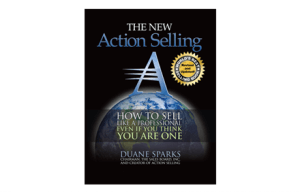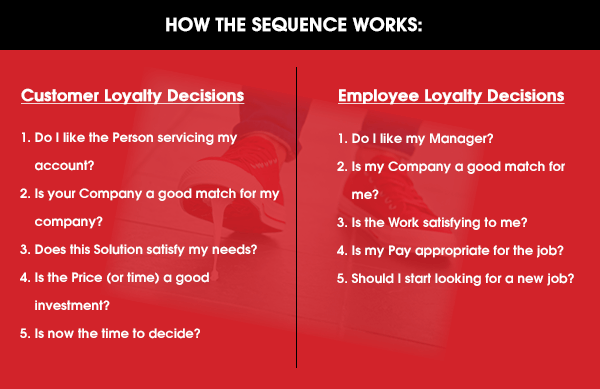
A WORD FROM DUANE SPARKS
Dear Sales Executive:
How many things do you feel you know for sure about how to create loyalty in customers? I can think of at least two basic truths. One is that customer loyalty is created by people—in your case, that means your work force. The other truth is that you can’t develop loyal customers very well with a work force that isn’t loyal to your company.
If you want loyal customers, therefore, the first question becomes: How do you build a loyal work force? Glad you asked, because, wow, do I have a great answer to that one. Please read on.
If you have a question about how to create loyal employees who can then create truly loyal customers, click on “Ask The eCoach“.
We are committed to your professional success.
Duane Sparks
Author of Action Selling ®
If You Want “Sticky” Customers, You Need a Sticky Work Force.
 I have read volumes about how to develop more loyal customers. The most intelligent and honest experts on the subject will tell you that people do not feel real loyalty toward corporate entities in the abstract. They might feel loyal to a cause or a duty, but mostly people feel loyalty only to other people. The best experts also will tell you that if your employees feel no loyalty toward your company, they aren’t going to generate loyalty among your customers, either.
I have read volumes about how to develop more loyal customers. The most intelligent and honest experts on the subject will tell you that people do not feel real loyalty toward corporate entities in the abstract. They might feel loyal to a cause or a duty, but mostly people feel loyalty only to other people. The best experts also will tell you that if your employees feel no loyalty toward your company, they aren’t going to generate loyalty among your customers, either.
If you want “sticky” customers, you need a sticky work force.
So how do you create one of those? I have studied this question quite a bit, too. What my research turns up is a multitude of “tips.” For instance, pay your people well and on time. Put loyalty into your mission statement. Hire people who have proven to be loyal. Celebrate employees who stick around.
Tips like those are helpful. I have no argument with them. However, a collection of tips does not represent a process that you can use consistently every day. I know for sure that if you want true loyalty, then building loyalty cannot be something you work on from time to time. Your efforts must be consistent, and they must be part of a coherent process.
So let’s talk about an actual process for creating sticky employees.
When I look at the incremental decisions that employees make in the course of developing a loyal relationship with a company, the decision-making sequence looks exactly like the one that customers use when evaluating your people, your solutions, and your company.
Since these are the loyalty decisions that employees make, why not follow a process that appeals to each of them?
Why not follow a loyalty process that matches the employee’s decision-making process?
If the first loyalty decision an employee makes is about their manager, the manager needs to do things that sway that decision in the right direction. To begin with, you should have a Commitment Objective for every interaction with an employee. The Action Selling ® process calls this Act 1.
Take some time to get to know your employees, and demonstrate your interest in them while you do. In Action Selling ® terms, this is Act 2.
When an employee has a need of some kind, use your Act 3 skills: Ask the Best Questions to clearly understand the need and search for potential solutions.
When Acts 2, 3, and 4 are done well, you “sell yourself” to the employee. You must do this before you can sell anything else—such as your company.
Completing Act 5 is a great idea. It’s called “Positive Company Statement” in the Action Selling ® CRP program for customer relationship professionals. When you consistently make positive statements about the company and what it is doing, you reinforce feelings of loyalty.
In Act 6, we match the employee’s needs to solutions we have at the company.
Act 7 is a simple but critical step. Based on whatever Commitment Objective you set for an employee interaction, just ask the person how you and the company did: “Are you satisfied that I handled this in the best possible way for you?”
At bottom, Action Selling ®—and Action Selling ® CRP—are really a consistent communication process carefully designed to gain loyalty commitments from customers. The same concepts and principles apply to your employees. When you manage the communications process properly, you get sticky employees. And sticky employees are the only ones capable of creating sticky customers.
Learn much, much more about how to create true loyalty in customers and in your work force. Click here for a free copy of my latest book, Masters of Loyalty.
Action Selling ® CRP in Action
If you want to create a more loyal work force, an excellent idea is to provide employees with great training that makes them better at their jobs (boosting confidence and self-esteem) and also makes the work environment more enjoyable and rewarding.
When Bergen KDV, a fast-growing regional CPA firm in the Upper Midwest, introduced its accountants and other employees to the new Action Selling ® CRP training program, the program did exactly that kind of double duty. Says Bergen partner Lee Roberts:
“Our primary goal for training our customer-contact staff at Bergen KDV was to align sales and service with a repeatable customer-communications process. We got much more than we expected. Within days following the initial launch of the CRP program, the office was alive with comments about how we were communicating on a better level, not just with clients, but with each other. Our internal sales and service teams have actually found a way to work better together!”
For information about how to make sales training pay huge dividends, contact Action Selling ® at (800) 232-3485.
Ever wish you could take a postgraduate course in building customer and employee loyalty that also happens to be a quick, easy read? Get a free copy of my latest book, Masters of Loyalty.
Recent eCoaches
Don’t Look Now, But Your Sales Culture Gap is Growing
Close Your Culture Gap! Align Sales and Service
Why 64% of Salespeople Don’t Close
Stalls Vs. Objections: No, They Don’t Have the Same Solution
No Detours! Why Must You Leave the Sales Path Just to Handle an Objection?
I Object! (To the Way You Define Objections)
How to Train Your Way Out of a Sales Slump
It’s Not What You Sell, It’s How You Sell
How Do You Know If Your Sales Force Is Good?
“One Call” Close Not Dead Yet?
TQM for Sales Leadership? Yes!
Six Critical Processes for Sales Leaders
10 Great Ideas About Sales Leadership
The Three Core Roles of Every Sales Leader
The Nine Acts of Sales Leadership
5 Secrets to Record-Breaking Sales
Sales Training That Actually Works
The Sales Leader’s Toughest Challenge
How Strong is Your Sales Culture?
Want to Create the Best Sales Culture?


ASSESS YOUR SALES SKILLS
Unlock your hidden sales potential today – take our free Selling Skills Assessment.

THE NEW ACTION SELLING
A Quick Read That Will Boost Your Sales — Guaranteed!


